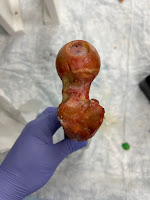Hunter Gaudio - Dr. Elemento, Dr. Cristofanilli - Summer Immersion Term, Week 4
This was another productive week focused on liquid biopsy research and clinical implementation. On Monday, the Circulating Tumor Cell (CTC) lab team met with members from the Institute of Computational Biology (ICB) to discuss an analysis plan for the whole exome sequencing (WES) dataset we are receiving from Natera. This data was generated from the primary tumors of patients who underwent circulating tumor DNA testing using the Signatera platform. We learned that the ICB already has a pipeline built that uses and cross-checks several methods for variant identification. Running the data through this pipeline should provide us with a comprehensive mutational profile of each patient's tumor, that we will then be able to evaluate, contextualized with clinical information. The initial goal of this analysis will be to characterize the performance of Signatera's liquid biopsy test across different mutational profiles. In the afternoon we had Dr. Cristofanilli's lab meeting where ...





